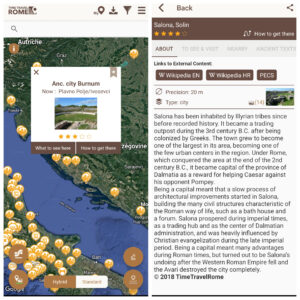Dalmatia is the coastal region along the Adriatic Sea from the island of Pag in the North of Croatia to Kotor in the neighboring country of Montenegro. The long Dalmatian coast is one of the most touristic regions of Croatia thanks to the beauty of its sea, numerous scenic islands and also thanks to its rich ancient remains.
History of Dalmatia
The most ancient inhabitants of Dalmatia were probably Illyrians of which the current Albanians seem the last descendants. Other local inhabitants were Liburnians – the seafaring people inhabiting the coastline. The coastal area of Dalmatia was colonized then first by Phoenicians, then by Greeks.
In 181 BC, the Romans established their colony at Aquileia and took control of all Venetia in the north. Roman legions then moved southward, defeating the southern Illyrians and the local king Gentius in 167 BC. In 59 BC, Illyricum was assigned as a provincia to Julius Caesar, and the main Liburnian city of Iadera (modern Zadar) was proclaimed a Roman municipium.
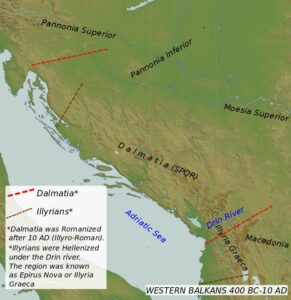
Romanized and Hellenized Illyria & Dalmatia Map. By MaryroseB54 – Own work, CC BY-SA 4.0.
But Roman rule in Illyricum stayed only nominal as local Illyrian and Liburnian pirates controlled large parts of the coast and systematically attacked trade routes. In 35 BC Octavian organized a major military operation, to finally stabilize Roman control over the province.
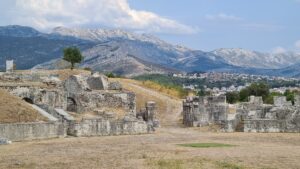
Panorama of the ancient Salona. Full TimeTravelRome Salona album: Link.
After the division of the empire in the 4th century AD, Dalmatia was attributed to the Empire of the West, but shortly after the death of Honorius (423 AD) it was reunited with that of the East. After the fall of the Western empire, Dalmatia was conquered by the tribe of Heruli, and then it was attached to the kingdom of Ostrogoths. After that, during the rule of Justinian, the area fell again under the control of Constantinople.
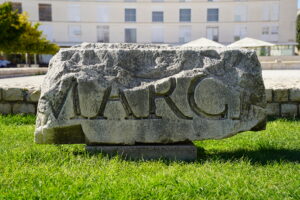
Monumental stone on the Forum of Zadar. Full TimeTravelRome album with ancient Zadar photos: Link.
Starting from the 6th-7th centuries, Dalmatia was controlled by Avars, then by Slavic tribes, who recognized the suzerainty of the Frankish emperors, but major cities on the coast fell in the 9th century under control of the Greek empire. The area was controlled by local princes with alternate influence from Croatia, Byzantium and Venice.
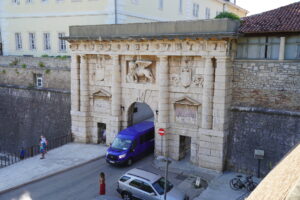
City gates of Zadar with a Lion – symbol of Venice. TimeTravelRome album with Zadar photos: Link.
Under the reign of Bela IV (1235-1270), Dalmatia was shortly invaded by the Mongols who were pushed back. In 1409, the King Ladislaus of Naples – an unsuccessful claimant to the kingdoms of Hungary and Croatia – sold his rights to Dalmatia to the Republic of Venice for 100,000 ducats. Dalmatia remained in Venetians possession until the end of the 18th century.
In this article we will highlight all major Roman sites of the ancient Dalmatia, as well as most important archaeological museums of Dalmatia. We are starting the journey with one of the main touristic destination of the Dalmatian coast – the city of Split.
Split and Diocletian Palace
The modern city of Split in the south of Croatia, Spalatum was originally founded as a colony by the Greeks from the Sicilian city of Syracuse. Known as Aspálathos, the colony was founded between the 3rd and 2nd centuries B.C. By merit of its position on the Dalmatian coast, the city was mainly used as port of passage, ferrying peoples around the Mediterranean.
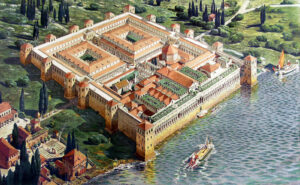
Diocletian Palace in Split. By Ernest Hébrard (recoloured by DIREKTOR), Public Domain.
Spalatum came under Roman control in the early part of the 1st century A.D. Under imperial control, the city flourished. It became an important port, prospering in the relative peace ensured by the Roman Empire. The apogee of Spalatum arrived in the later imperial period. It was at Spalatum that the Emperor Diocletian built his palace – the ruins of which areas of the modern city are built in. After the fall of the Western Roman Empire in 476 A.D., the city endured for a while as one of the most prominent cities in the Byzantine Empire.
Diocletian Palace
The Diocletian Palace in Split was built at the end of the 4th century as the retirement residence of Diocletian. One of the best preserved and impressive parts of it is the Peristyle – the central part of the Palace.
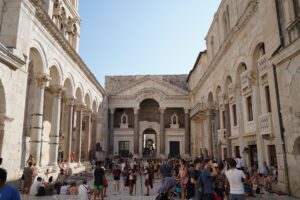
Peristyle – the central part of the Palace. Full album: Link.
The Palace was decorated with 3500-year-old granite sphynxes dated to the times of the Egyptian Pharaoh Thutmose III. Three of them have survived. One is on the Peristyle, the second sits in front of Jupiter’ temple.
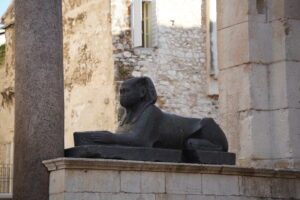
Granite sphynx dated to the times of Thutmose III. Full album: Link.
The Mausoleum of Diocletian later became the Cathedral of St. Domnius. The original dome had an oculus.
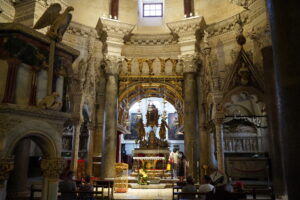
The Mausoleum of Diocletian – the Cathedral of St. Domnius. Full album: Link.
Decorative freeze refers to the after-life symbolism.
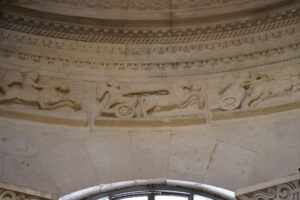
Decorative freeze in the Mausoleum of Diocletian. Full album: Link.
The Temple of Jupiter was built between 295 and 305 AD, and it is very well preserved.
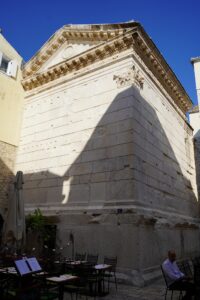
The Temple of Jupiter. Full album: Link.
The vaulted ceiling of the Temple consists of 64 panels, each with decorated sides.
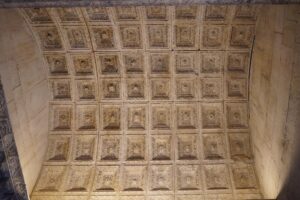
The vaulted ceiling of the Jupiter Temple. Full album: Link.
Some panels have faces representing a particular emotion.
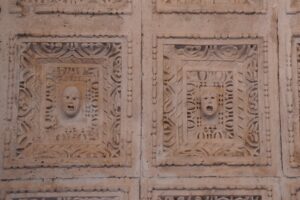
Panels of the Jupiter Temple vault. Full album: Link.
The so-called Vestibule is the Atrium of the Palace. Its roof has an opening called Oculus.
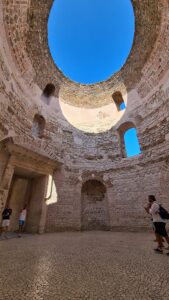
Vestibule is the Atrium of the Palace. Full album: Link.
This is the Porta septemtrionalis or the Golden Gate & its inner view. On the left & right side of the gate are niches where the statues of the Tetrarchs stood: Diocletian, Maximian, Galerius and Constantius Chlorus. The door was defended by two octagonal towers since lost.
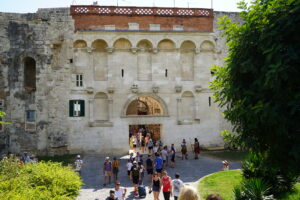
Porta Septemtrionalis or the Golden Gate. Full album: Link.
The Archaeological Park of the Ancient Salona
Salona has been inhabited by Illyrian tribes since before recorded history. It became a trading outpost during the 3rd century B.C. after being colonized by Greeks. The town grew to become one of the largest in its area, becoming one of the few urban centers in the region. Under Rome, which conquered the area at the end of the 2nd century B.C., it became capital of the province of Dalmatia as a reward for helping Caesar against his opponent Pompey.
Many of the civil structures that made Salona into the Dalmatian capital left ruins in a good state of preservation, such as the amphitheater and the aqueduct, and a large area of the city is still visible through the existence of partial perimeter walls. Inside the ruins an ancient Christian church stands between Roman ruins, attesting to the importance of early Christianity in Salona. The city was prosperous during roman times, but it was ruined by Avars in the 7th c. AD.
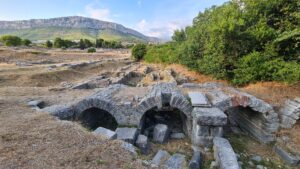
The so-called “Five Bridges” in the Archaeological park of Salona. Full album: Link.
The archeological park of Salona is the place where the ruins of the ancient city still can be seen by visitors. The most prominent structure in the archaeological parc is the Amphitheater. Built in the 2nd century, it could have up to 18.000 spectators, compared to 60.000 inhabitants of Salona at that time. The structure was partly destroyed during the 17th century wars with Turkey.
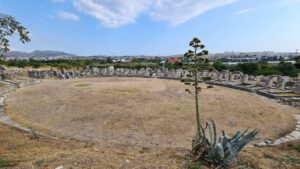
The Amphitheater of Salona. Full album: Link.
The earlier part of the Roman city corresponds to the area around the Forum & Theatre – they are less prominent than the Amphitheater but still well visible today.
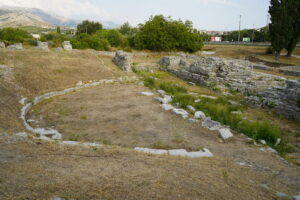
The Theater near the Forum. Full album: Link.
Salona had a mint connected with silver mines in the Dinaric Alps through Via Argentaria. Several other regional roads started from Salona gates, the best preserved being the the Porta Caesarea. Its stone paving still keeps traces of roman carts.
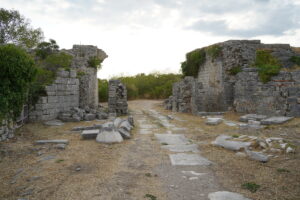
Porta Caesarea. Full album: Link.
An aqueduct was built under Augustus – it carried water from the river Jadro, supplying the city and its Baths. The biggest bath is called Great Thermae – it occupies the prominent place in the eastern part of the city.
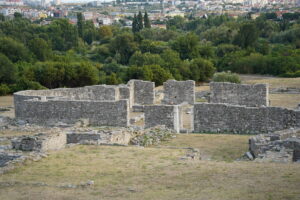
Great Thermae. Full album: Link.
Since antiquity, Salona was an important Christian center. The oldest church of Salona was used since the middle of the 3rd century. Later, at its original location, a huge episcopal center was built in the 5th century AD.
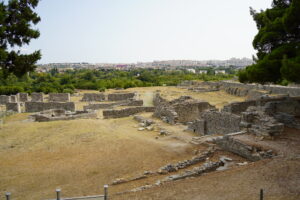
Remains of the episcopal center. Full album: Link.
Another Christian place just outside of Salona is the so-called “Manastirine”. The first complex was destroyed by Germans in the 3rd c., but a larger basilica was rebuilt here in the 5th c. Many martyrs killed in the nearby amphitheater were buried here.
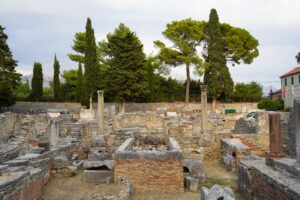
Manastirine. Full album: Link.
Guests to Salona can also visit “Tusculum” – a memorial Museum dedicated to Frane Bulić, the first archaeologist of Salona. The facade of the Museum is using ancient parts.
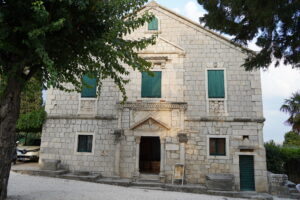
Tusculum. Full album: Link.
Trogir – Hidden gems of the ancient Tragurion
The Greek Tragurion was founded as a trading outpost by colonists from the island of Vis in the 3rd c. BC – modern Trogir has kept the same city plan.
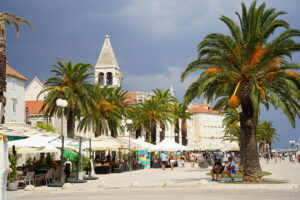
Trogir is a popular touristic destination. Full album: Link.
The Greek city had megalithic walls – huge stones in the old city’ garden once belonged to these walls.
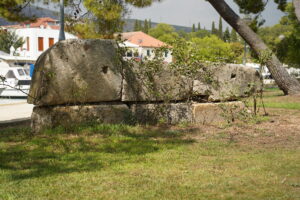
Remains of the ancient city walls. Full album: Link.
The City Museum hosts a small collection of roman tombstones and other monuments, but it also allows seeing remains of the ancient water conduct system & walls dated to Roman times.
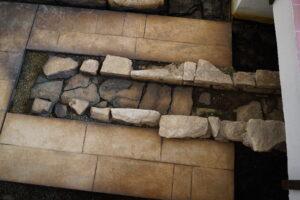
Water conduct system dated to Roman times. Full album: Link.
Ancient stone monuments include a miliarium of Trajan, a representation the Illyrian god Sylvanus, an altar dedicated to Hercules as well as some examples of the very early Christian art (4th century AD).
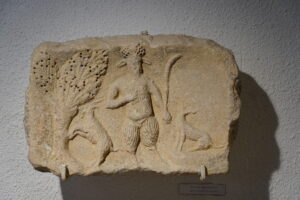
Representation the Illyrian god Sylvanus. Full album: Link.
One of the main highlights of the ancient Trogiris the relief of Kairos – God of Happy Moments. It is kept in the Benedictine nunnery of Trogir. Kairos appears on this exceptional relief as a naked young man with a tuft of hair – one needs to grab it at the right moment or the chance will be lost forever as Kairos is always in a hurry! The ancient Greeks had two words for “time”: chronos and kairos. The former refers to chronological time, and the latter signifies a moment of time in which something special happens. “Kairos” is used 86 times in the New Testament, whereas “chronos” is used there 54 times.
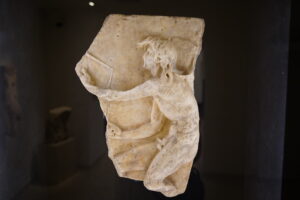
Kairos relief. Full album: Link.
The original bronze statue of Kairos was made by Lysippos and it stood in the Agora of Sikyon. Kairos is described in the epigram of the poet Posidippos from 3 th c. BC:
– Who are you?
– Time who subdues all things.
– Why do you stand on tip-toe?
– I am ever running
– And why you have a pair of wings on your feet?
– I fly wilh a wind.
– And why do you hold a razor in your right hand?
– As a sign to men that I am sharper than any sharp edge.
– And why does your hair hang over your face?
– For him who meets me to take me by the forelock.
– And why, in Heaven’s name, is the back of your head bald?
– Because none whom I have once raced by on my winged feet will now, though he wishes it sore, take hold of me from behind. – Why did the artist fashion you?
– For your sake, stranger, and he set me up in the porch as a lesson.
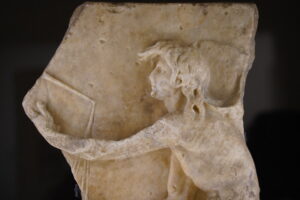
Kairos relief – detail. Full album: Link.
Another hidden gem of Trogir is the St. Barbara Church. It was built in the 9-10th century from fragments of ancient stones. The portal is constructed of parts of a sarcophagus, decorated by Early Christian crosses.
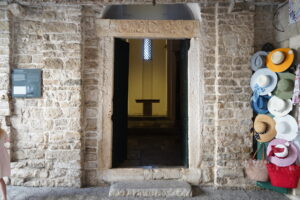
St. Barbara Church – entrance. Full album: Link.
The ancient columns are seen inside.
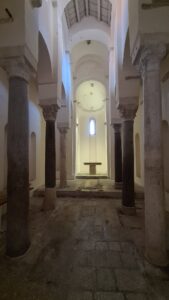
St. Barbara Church – inside. Full album: Link.
Zadar – The Roman city of Iader
Founded as an Illyrian outpost during the 11th century B.C. and dominated by the Liburnians, Iader was an important trading hub. The city was helped by its strategic position: it was the main port on the trade route to the Balkans. Thanks to that, the city became prosperous, adopting Roman culture and customs. When the western Roman Empire fell apart, and the Dalmatia region was abandoned, most of the roman citizens retreated to Iader, making it one of the last strongholds of Roman culture in the region until medieval times.
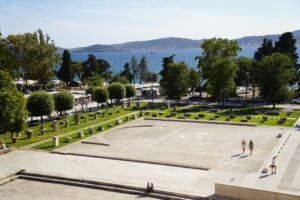
Roman Forum of Zadar. Full album: Link.
Most Roman remains were destroyed in medieval times, but some sites still can be seen and visited. The ancient Roman forum has been excavated inside of the city and is open to visitors. Built under Augustus, this forum is the largest one on the eastern side of the Adriatic Sea.
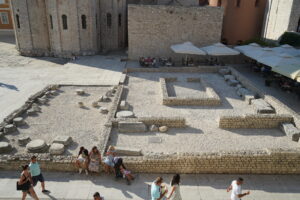
Remains of houses and tavernas near the Forum. Full album: Link.
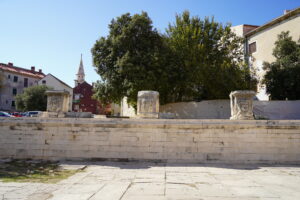
Roman Temple of Jupiter, Juno and Minerva. Full album: Link.
The St Donatis Church of Zadar was built in the 9th century – the impressive medieval building literally stands on remains of the Roman temple and Forum.
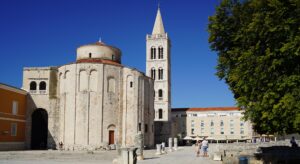
The St Donatis Church of Zadar. Full album: Link.
Internal structures are almost entirely built from roman spolia. The church is the largest pre-romanesque building in Croatia.
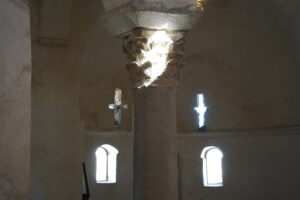
The St Donatis Church of Zadar. Full album: Link.
Many important finds can be seen in the Archaeological Museum of Zadar – more about it at the end of this article. Zadar also hosts a spectacular Museum of Ancient Glass, also described in this article below.
The Ancient Narona
Situated within the Roman province of Dalmatia, Narona emerged as an important focus of Roman power in the region and a base from which revolts could be put down. The presence of many merchants and soldiers made the city wealthy: archaeological finds include luxurious private homes and expensive statuary.
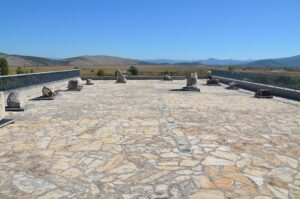
Archaeological museum Narona, Vid, Croatia. By Carole Raddato. CC BY-SA 2.0.
After going into decline as a commercial center, the city came under Byzantine rule in the 6th century AD and was finally abandoned a century later. It is still possible to see the ruins of Narona’s walls and the foundations of various buildings. Of particular note is a group of statues known as the Augusteum that depicts the emperor Augustus and his family. Finds are preserved in the Archaeological Museum in Narona, which occupies the site of the ancient forum.
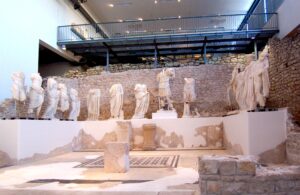
Statues of emperor’s family (from left): Lucius Caesar, Julius Caesar, Julia, Marcus Vipsanius Agrippa, Antonia Minor, Octavia the Younger, Livia, Augustus, Tiberius, Germanicus, Nero Claudius Drusus, Claudius, Agrippina the Younger, Agrippina the Elder, Vespasian. By Rolf Kawel – Self-photographed, CC BY-SA 3.0 de.
Military Camp and Amphitheater at Burnum
The Roman city of Burnum is thought to have been founded in 33 BC, or possibly later. The fort here was heavily used by legions fighting to control the region early in the first century AD.
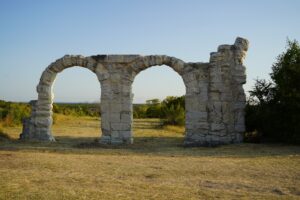
Triumphal arch at Burnum. Full album: Link.
In AD 42, however, legionaries based at the fort began their own rebellion against the emperor Claudius. After the legions vacated the site in AD 86, it developed as a primarily civilian settlement. It was recognized as a city under Hadrian, though little is now known about its exact size. Archaeologists have identified the remains of a temple to Jupiter and an amphitheater among other structures.
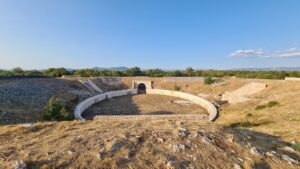
Roman Amphitheater at Burnum. Full album: Link.
Ultimately, the city was destroyed by Justinian in the 6th century after it had fallen into the hands of the Ostrogoths.
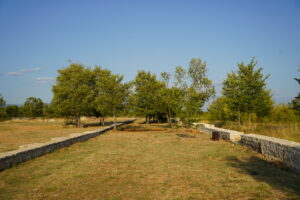
Roman camp at Burnum. Full album: Link.
Among the ruins that are visible today, the most impressive are the remains of an arcade of five arches, of which two remain standing. Nearby are the ruins of the city’s amphitheater.
Epidaurum – Cavtat
The Greek colony of Epidauros was founded in the sixth century BC and ultimately came under the rule of Rome in 228 BC, as Epidaurum, as part of the province of Illyricum. It was besieged by Pompey during the civil war between his armies and those of Julius Caesar but it managed to survive destruction through the centuries until the seventh century AD, when it fell to the Avars and Slavs.
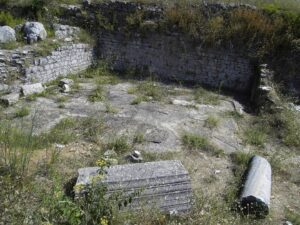
Cavtat Archeological site. By Erud – Own work, CC BY 3.0.
Refugees from the city went north and founded a new city, which in due course became Dubrovnik. Ruins of the ancient city include a villa, baths and the remains of an aqueduct. Finds from the site, among them pottery and inscriptions, may be seen in museums in Cavtat and Dubrovnik.
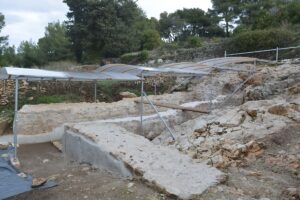
Cavtat archaeological site. Source: dulist.hr
Ancient municipium Riditarum (Rider) – Danilo
Danilo is one of the most significant archeological sites in Croatia. Remains of the Municipium Riditarum include a villa with a bath, houses and details of a temple. Before Romans, Danilo was hometown of the eponymous Neolithic culture known by its enigmatic cultic vessels. Here are a few pictures of the Danilo culture (4700-3900 BC) – nobody understood the purpose of these vessels yet.
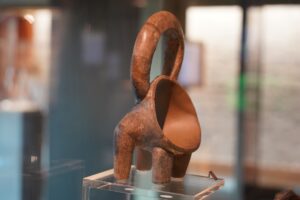
Cultic vessel – Danilo Culture. Sibenik Museum. Full album: Link.
The settlement was flourishing during the roman times, achieving the rank of municipium under the Flavian emperors in the second half of the 1st century A.D. Several of the structures uncovered here are monumental in scale.
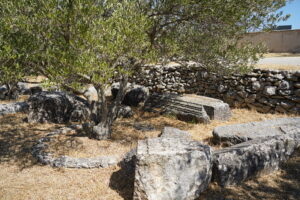
Archaeological site of Riditarum – Danilo. Full album: Link.
One of the most prominent of these was an expansive villa with accompanying bathing complex.
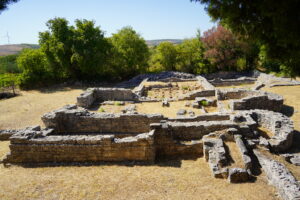
Archaeological site of Riditarum – Danilo. Ancient Baths. Full album: Link.
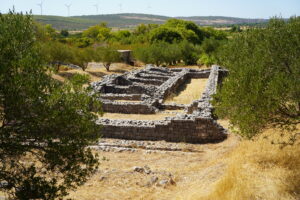
Archaeological site of Riditarum – Danilo. Roman Villa. Full album: Link.
Later in the imperial period, this bathing complex was converted into an Early Christian church.
Monumental Temple at Aenona – Nin
The modern city of Nin in the Zadar county, Aenona was one of the oldest settlements on the Adriatic. From the 9th century B.C., it was the home of the Liburnian people, an Illyrian tribe. Aenona was incorporated into the Roman world early in the 1st century AD and granted the status of municipium by the Emperor Tiberius. By the start of the 6th century AD the area fell under Ostrogothic control.
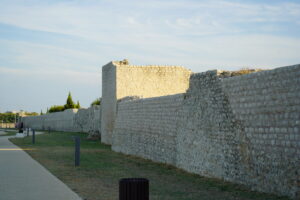
Ancient walls of Aenona. Full album: Link.
Fragmentary remains of the ancient city are still visible. Under the later medieval walls, one can identify the foundations of the Roman circuit upon which they were built.
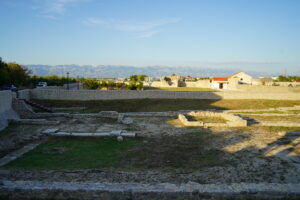
Remains of Roman houses at Aenona.
The remains of a forum with a monumental temple are also identifiable. The temple is believed to date to the late 1st century A.D., and the reign of the Flavian emperors. Statues of the Emperors Augustus and Tiberius have been discovered here, leading to the identification of this temple as being dedicated to the imperial cult. Finds from Aenona are housed in both the local museum in Nin, and at the Archaeological Museum in Zadar.
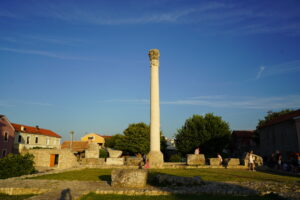
Remains of a monumental temple at Aenona. Full album: Link.
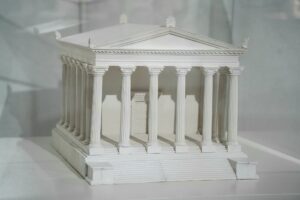
Reconstruction of the temple at Aenona. Full album: Link.
The ancient Aenona also hosts today a nice Museum where one can see remains of ancient ships.
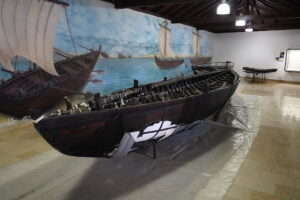
Ancient ships in the City Museum of Nin. Full album: Link.
Another attraction is the picturesque Church of the Holy Cross, which dates to the 9th Century AD.
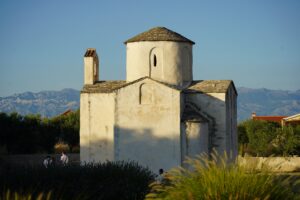
Church of the Holy Cross. Nin. Full album: Link.
The ancient Harbor of Colentum
Colentum is an ancient Libourno-Roman harbour located on the island of Murter. Most of it is below the sea level, which was some 1.5 m lower in antiquity. Interesting fact: today the sea level is higher mostly because of the continuing post-glacial crust rebound, and not because of any ice meltdown…
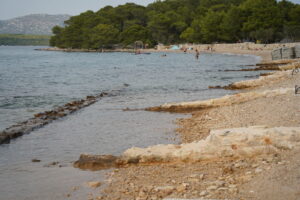
Harbor of Colentum. Full album: Link.
Not much is left of the ancient Colentum, excepting a few picturesque walls washed by sea waves.
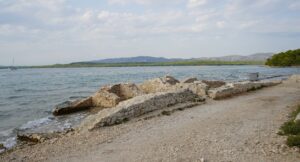
Harbor of Colentum. Full album: Link.
There are also some visible remains of ancient houses on the slope of the hill overlooking the harbor.
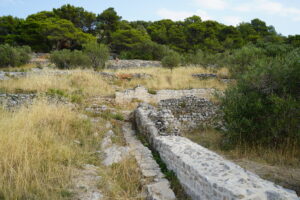
Ancient houses of Colentum. Full album: Link.
Libournian Fortress of Asseria
The small Croatian village of Podgrade is the site of an ancient hillfort settlement called Asseria. The home of the Asseriates tribe in pre-Roman times, it became a military post under the Romans during the first century AD. The presence of the Romans promoted the development of Asseria as a center of trade and commerce and, probably during the reign of Claudius, it acquired the status of a municipium.
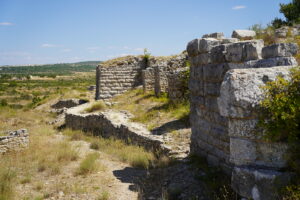
Fortress of Asseria. Fortification walls. Full album: Link.
Surviving features of ancient Asseria include parts of the pre-Roman walls and a triumphal arch dating to AD 113, during the reign of the emperor Trajan. Archaeologists have also unearthed the forum and what is thought to be a basilica. Finds from the site are preserved in the Archaeological Museum in Zadar.
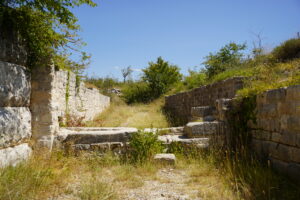
Fortress of Asseria. One of the entrance gates. Full album: Link.
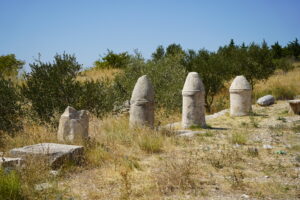
Fortress of Asseria. Cylindrical gravestones – “cipus”. Full album: Link.
Breberium – Varvaria – Bribir
Located on the Bribirska Glavica hilltop, this spectacular and very rich archaeological site was first a Liburnian site, then a roman fortress transformed into a Croatian medieval stronghold. The hill is so rich in history that it is sometimes called “Croatia’s Troy”.
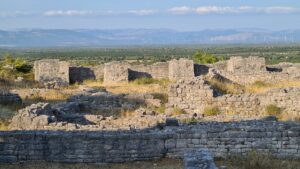
Bribirska Glavica hilltop. Ancint fortress. Full album: Link.
The site is being actively explored by archaeologists – a very informative website is dedicated to the excavations http://www.varvaria-breberium-bribir.org
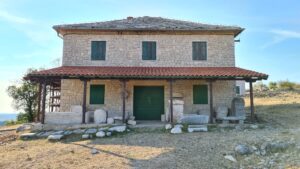
Museum at the archaeological site of Bribir. Full album: Link.
Besides its historical interest, Breberium offers splendid views over the surrounding valley.
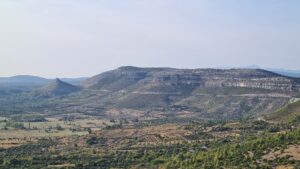
Scenic views on the road to Breberium. Full album: Link.
Velika Mrdakovica – Liburian and Roman site
This fortified liburnian site was founded on the top of the hill in the 7th century BC and remained occupied until the end of the 2nd century AD. The site is sometimes associates with the ancient Arauzona (Arausa), but this attribution remains uncertain. Remains of the ancient fortified walls and houses can be seen and visited on the slopes of the hill.
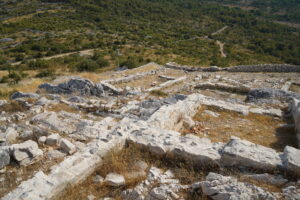
Velika Mrdakovica – Liburian and Roman site. Full album: Link.
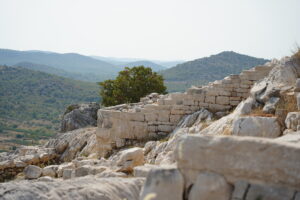
Velika Mrdakovica – Liburian and Roman site. Full album: Link.
Split Archaeological Museum
The Archaeological Museum in Split requires some renovation, and many spectacular finds are exhibited outside of the main building, exposed to weather and air pollution.
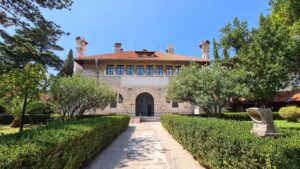
Split Archaeological Museum. Full album: Link.
However, the place definitely deserves a visit. Here are a few highlights form the Museum collection.
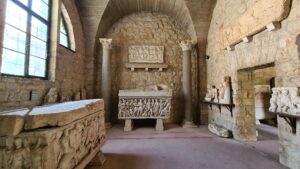
Split Archaeological Museum. Gallery. Full album: Link.
This is a sarcophagus dated to 260 AD, produced by an Athenian workshop in ancient Salona. It is decorated with erotes climbing vine tendrils.
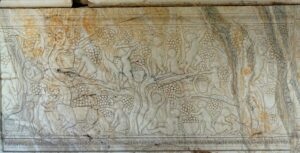
Split Archaeological Museum. Sarcophagus produced by an Athenian workshop. Full album: Link.
This a mosaic panel with Orpheus and Animals from the Dalmatia Governor’s house in Salona. It is dated to the end of the 2nd century and is one of the prize objects of the Museum collection.
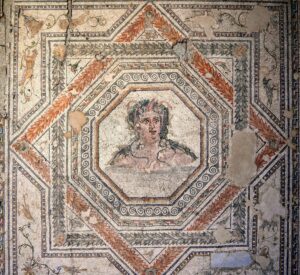
Split Archaeological Museum. Mosaic representing Orpheus and Animals, from the Dalmatia Governor’s house in Salona. Full album: Link.
Sibenik City Museum
The city of Sibeik didn’t keep many traces of its Roman past, but its City Museum hosts a rich exhibition of ancient finds from the area. A few highlights are presented below.
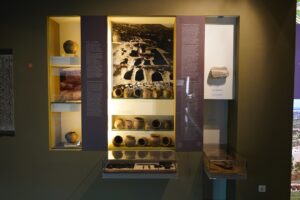
Sibenik City Museum. Full album: Link.
This snail-shaped glass rhyton was found in 2011 at Velika Mrdakovica in Croatia. It was made by blowing glass into a mould with later addition of details. Only 18 such rhyta including this one were found.
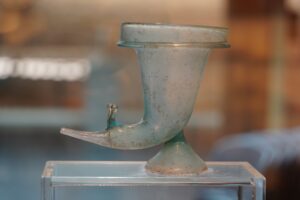
Sibenik City Museum. Snail-shaped glass rhyton found at Velika Mrdakovica. Full album: Link.
Because of its property to electrify by rubbing, Amber was attributed magical powers. Romans believed that it protected from disease & bad dreams. Amber rings were not worn on fingers, but hung around the neck. This ring was found in Skradin and is now part of the Sibenik City Museum collection.
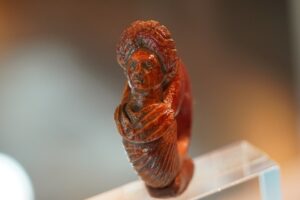
Sibenik City Museum. Amber ring. Full album: Link.
Zadar Archeological Museum
The Archaeological Museum of Zarar has a very rich collection of finds.
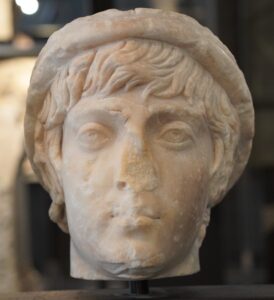
Zadar Archeological Museum. Marble head of a priest. Full album: Link.
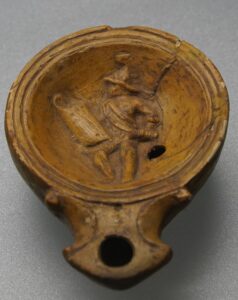
Zadar Archeological Museum. One of the many oil lamps in the Museum collection. Full album: Link.
One of the main highlights of the collection is the Augustus statue found in ancient Aenona (Nin) in 1777 with seven other statues. Three of them are now in the Zadar Archaeological museum. The second statue is of Tiberius, and the third is headless, but was possibly representing Julius Caesar.
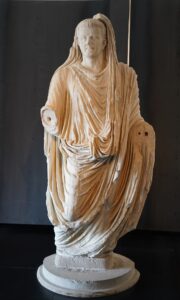
Zadar Archeological Museum. Statue of Tiberius. Full album: Link.
The Augustus statue is even more interesting that it first appears. It is actually a Caligula heroic statue, which was recut into a copy of Augustus Prima Porta type. The heroic statue of Caligula was that of Jupiter. Its head is made from a single block of marble and you may notice that the recarved head of Augustus is too small compared to the corona civica.
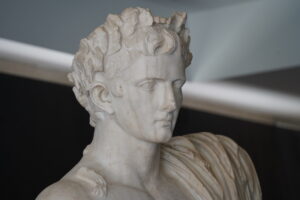
Zadar Archeological Museum. Augustus statue recut from Caligula’s. Full album: Link.
Zadar Museum of Ancient Glass
The Zadar Museum of Ancient Glass is certainly one of the main “hidden gems” on the Dalmatian coast. Its stunning collection is one of the biggest surprises I had so far during my trip along the Dalmatian Coast in Croatia.
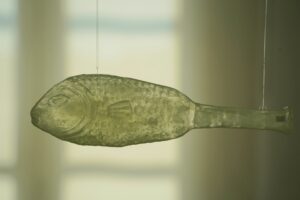
Glass vessel in the shape of a fish. Full album: Link.
The museum is dedicated to the ancient glass found in different areas of the ancient Dalmatia. The collection starts with some unique pieces, including a multi-color cup, a glass portrait of Empress Livia and a glass phalera with a portrait of Tiberius.
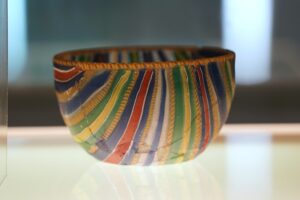
Multi-color cup. Full album: Link.
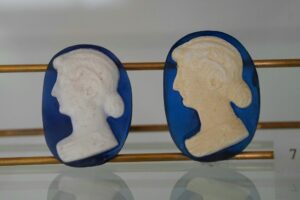
Glass portrait of Empress Livia. Full album: Link.
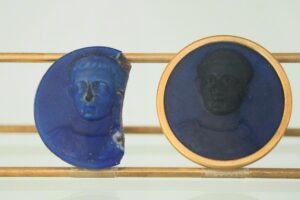
Glass phalera with a portrait of Tiberius. Full album: Link.
An entire museum room is dedicated to the glass tableware: several complete glass table sets can be seen in different colors.
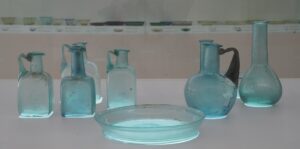
Roman glass tableware. Full album: Link.
Glass jewels are of special interest: even some hair pins were preserved.
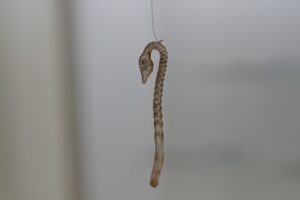
Roman glass hair pin. Full album: Link.
Funerary glass urns are very numerous. It is understandable why they are often intact: they were put inside of bigger stone urns, which kept them protected.
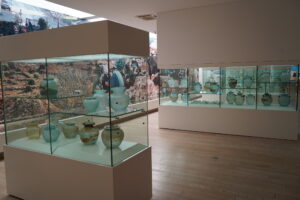
Funerary glass urns. Full album: Link.
Other beautiful highlights of the collection include cups with inscriptions, a corn-shaped drinking cup (rhyton) and numerous balsamaria, some of which have fancy shape – such as an amphora or a date.
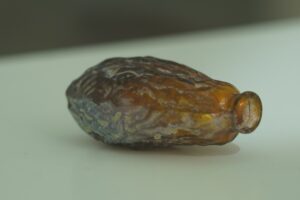
Balsamarium. Full album: Link.
Ancient Dalmatia on TimeTravelRome
Most of the text in this article is coming from Timetravelrome – our app dedicated to the ancient Roman Empire. The App allows finding all most interesting travel destinations across the whole Roman Empire, including the Dalmatian coast of Croatia.
